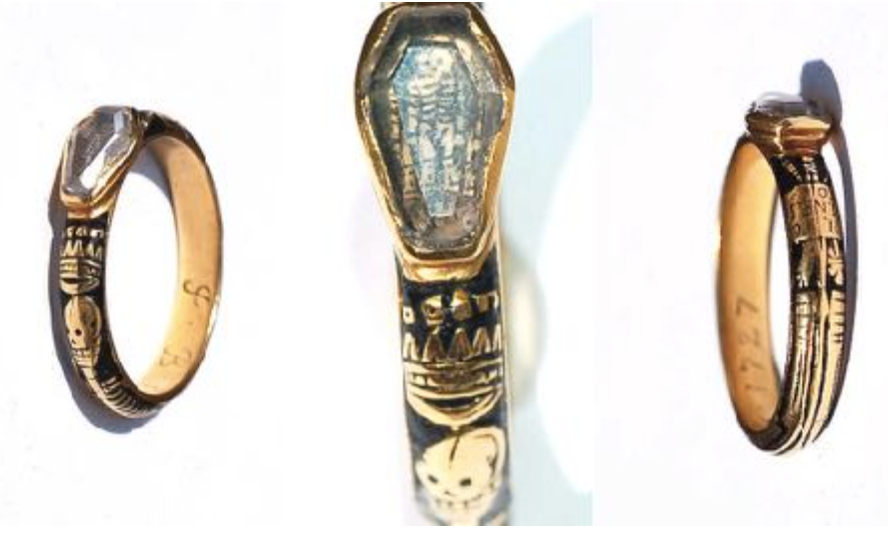
Mourning Jewelry: Momento Mori’s Through Time by Paige McKirahan
Though the concept of mourning jewelry has been around since the early 1600s, it did not truly come into its own as a common practice until the Victorian Era starting in 1937. Prior to this period, mourning jewelry commonly featured skulls and other grave related imagines. It seemed to more so focus on the fact that death was inevitable, rather than the memory of a lost loved one. When the Georgian era ended and this new era began, the pieces began to become less macabre and instead took on softer appearance.
Mourning ring from 1727 featuring a multiple skulls and a coffin shaped gem

Queen Victoria, who currently still holds the crown for longest reigning monarch in history, was in power from 1837 to 1901. When her husband, Prince Albert, passed away in 1861, the Queen was beside herself with grief. This grief materialized in the form of mourning jewelry and black clothing on the Queen and members of her court for decades. After this display by Victoria, the public took note and began to really immerse themselves in the idea of creating sentimental pieces to honor their loved ones.
During the Victorian Era, the social customs were very strict and varied according to status and wealth. For women, they were very detailed; they exclusively wore black for a specific duration of time and were restricted on what other daily tasks they could participate in until the mourning period was complete. The use of these practices was considered to be a display of your feelings about the passing of a loved one and allowed those to express their grief outwardly.
The materials used to make these mourning pieces varied; jet, which is a fossilized coal that is black and shiny in appearance, was widely used but it was interchangeable with the cheaper vulcanite, gutta percha, onyx, black enamel, pearls, and bog oak. Black was a prominent color in mourning jewelry, but it is important to know that different colors could be incorporated to signify different stages of grief. In the final stages of mourning, darker colors like blue, purple and grey slowly crept back into the wardrobe.
Though the use of skulls, burial items, and morbid symbols came out of practice, they opened the door for more subtle depictions of the dead. The Victorian period brought in the use of clouds, weeping willows, angels, and women lamenting at tombs. They also would feature the initials or the name of the deceased along with their age or date of death.
Weeping willow mourning piece

In addition to those symbols, another extremely common component of mourning jewelry was hair; those in mourning would cut locks of the deceased’s hair and incorporate them into the pieces! They were primarily put directly into the jewelry, but the locks also frequently found themselves in lockets. When photography stepped out onto the scene, the hair was accompanied by photos of the deceased as an added memorial.
Mourning ring with locks of human hair

Though we do not regularly practice these customs today, history lovers and jewelry collectors alike are fascinated by these gaudy pieces honoring those of the past. Today, they can sell for thousands of dollars depending on era and style. If you are one looking to acquire some of these extremely unique pieces, head to your local antique show or log onto Ebay and start bidding!
Written by Paige McKirahan
Images credit to io9.gizmodo.com
